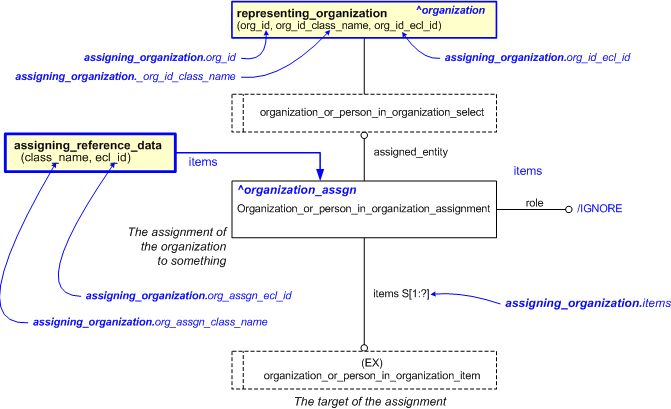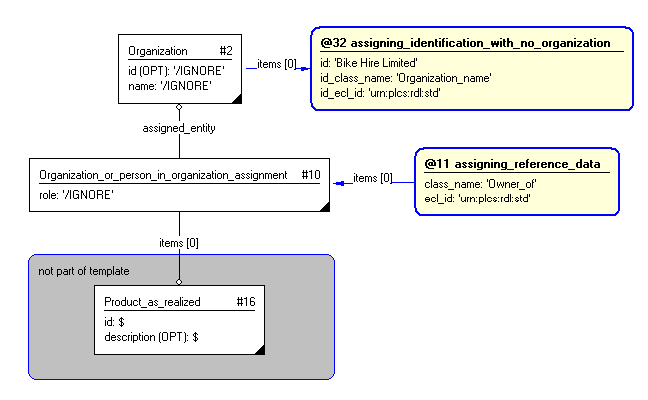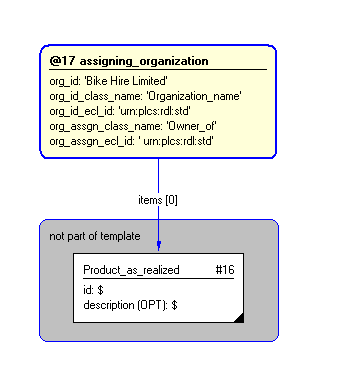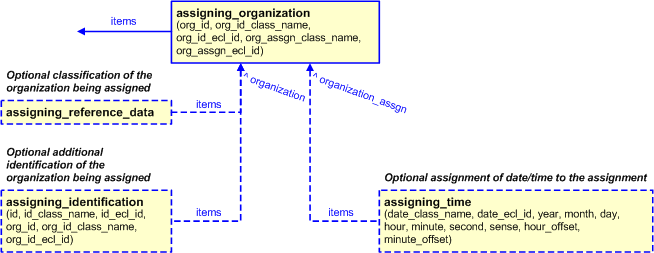| Template:— assigning_organization (asg_org) |
Date: 2008/03/05 07:05:56
Revision: 1.27
|
This section specifies the template assigning_organization.
NOTE
An explanation of a template and the associated instantiation path is
provided in the
Template overview
section.
This template describes how to represent
the assignment of an organization to something.
The purpose or meaning of the assignment is provided by
classifying the assignment.
The organization shall be identified and the type of identifier
provided by classification.
The EXPRESS-G diagram in
Figure
shows the templates and EXPRESS entities that are required
to represent the template
"assigning_organization".
The text highlighted in blue shows the template parameters.
NOTE
In any exchange file, an organization should only be represented by
a single instance of
Organization.
Figure 1 — An EXPRESS-G representation of the Information model for assigning_organization
The graphic for the template to be used in other EXPRESS-G diagrams
is shown in Figure
below.
Figure 2 —
The graphical representation of the assigning_organization template
The following input parameters are defined for this template:
The name or identifier of the organization.
The name of the class being used to classify the
identification
(
Identification_assignment)
of the organization. This provides the role or reason for the identification. For example CAGE code.
The following classes and their sub-classes can be used:
The identifier of the
External_class_library
storing the definition of the class referenced by the parameter @org_id_class_name class.
The following classes and their sub-classes can be used:
The identifier of the
External_class_library
storing the definition of the class referenced by the parameter @org_assgn_class_name.
The items to which the organization is assigned
The following reference parameters are defined for this template:
Allow the
Organization
entity instantiated in this path to be referenced when this template is used.
Note: The
Organization
entity can be referenced in a template path by:
%^target = $assigning_organization.organization%
where
target
is the parameter to which the
Organization
is bound.
%^target = $assigning_organization.organization_assgn%
The following parameter combinations specify a uniqueness constraint:
Unique constraint: Organization identifier
There shall be at most one instance of the
entity
(
Organization)
within the data set uniquely identified
by a combination of the following parameters on this
template (assigning_organization) namely:
org_id,
org_id_class_name,
org_id_ecl_id.
The
instance is
referenced by the following template parameter:
organization.
The instantiation path shown below specifies the entities that are to be
instantiated by the template.
-- Instantiate representing_organization -- NOTE - representing_organization should only be instantiated once for -- each organization /
representing_organization(
org_id=@org_id,
org_id_ecl_id=@org_id_ecl_id,
org_id_class_name=@org_id_class_name)/
-- Bind Organization instantiated by the representing_organization -- template to the ^organization parameter. -- The parameter is a reference parameter so that the Organization -- entity can be referred to when this template is used. %^organization = $representing_organization.org%
-- Instantiate an Organization_or_person_in_organization_assignment Organization_or_person_in_organization_assignment-- Bind the Organization_or_person_in_organization_assignment -- to the parameter ^organization_assgn -- The parameter is a reference parameter so the -- Organization_or_person_in_organization_assignment entity can be -- referred to when this template is used. %^organization_assgn =
Organization_or_person_in_organization_assignment%
-- Set the Organization_or_person_in_organization_assignment -- role attribute to be ignored Organization_or_person_in_organization_assignment.role = '/IGNORE'
-- Assign the organization to the -- Organization_or_person_in_organization_assignment Organization_or_person_in_organization_assignment.assigned_entity ->
^organization
-- classify the Organization_or_person_in_organization_assignment /
assigning_reference_data(
items=^organization_assgn,
class_name=@org_assgn_class_name,
ecl_id=@org_assgn_ecl_id)/
-- Assign the Organization_or_person_in_organization_assignment.items -- to the instances passed into the template through the @items -- input parameter Organization_or_person_in_organization_assignment.items ->
@items
The following entities are instantiated with attributes as specified:
The instance diagram in Figure
shows an example of the EXPRESS entities and templates that are instantiated by the template:
@17 /assigning_organization(items='#16', org_id='Bike Hire Limited', org_id_class_name='Organization_name', org_id_ecl_id='urn:plcs:rdl:std', org_assgn_class_name='Owner_of', org_assgn_ecl_id='urn:plcs:rdl:std')/
(an illustration of the consolidated assigning_organization template is shown in
Figure
below.)
Note that the templates
representing_organization and
assigning_reference_data
are used in the diagram.
Namely:
@1 /representing_organization(org_id='Bike Hire Limited', org_class_name='Organization_name', org_ecl_id='urn:plcs:rdl:std')/
and
@11 /assigning_reference_data(items='#10', class_name='Owner_of', ecl_id='urn:plcs:rdl:std')/
Figure 3 — Assigning an organization
The instance diagram in
Figure
shows the graphic symbol for the template that is to be
used in other instance diagrams. The example template is:
@17 /assigning_organization(items='#16', org_id='Bike Hire Limited', org_id_class_name='Organization_name', org_id_ecl_id='urn:plcs:rdl:std', org_assgn_class_name='Owner_of', org_assgn_ecl_id='urn:plcs:rdl:std')/
Figure 4 — Instantiation of assigning_organization template
The following section details how the
assigning_organization
template can be optionally characterized by assigning
other constructs to it. These are characterizations commonly
applied to the template. The ISO 10303-239 EXPRESS model may enable
other assignments to the entities instantiated by the template.
The EXPRESS-G diagram in Figure
5
shows the possible characterizations of the template
"assigning_organization".
Figure 5 — Characterizations of assigning organizations
The following characterizations may apply:
Characterization Identification of an Organization
NOTE this characterization is optional.
Multiple identifications can be assigned to an organization.
Characterization Classification of an Organization
NOTE this characterization is optional.
An organization can be classified by assigning reference data to the
Organization
entity representing it.
For example, the 'BikeHire Limited' organization can be classified as
an 'Bike operator'.
The assignment of reference data is described in the capability
C010: assigning_reference_data (NB Capabilities are not documented in this release of the PLCS standard)
.
Characterization Assigning time
NOTE this characterization is optional.
Dates and times may be associated with the assignment of an organization by
using the template
assigning_time.
For example, the date on which an organization took ownership of a
realized product, and the date at which the organization relinquished ownership
is represented by assigning a time to the
Organization_or_person_in_organization_assignment.





